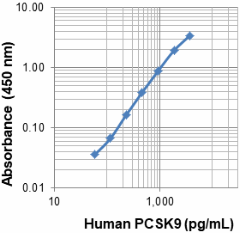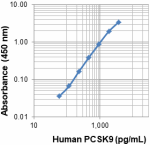- Clone
- M1118E3 (See other available formats)
- Regulatory Status
- RUO
- Other Names
- PCSK9, PC9, NARC1, Neural Apoptosis Regulated Convertase 1
- Isotype
- Rat IgG2b, κ
- Ave. Rating
- Submit a Review
- Product Citations
- publications

| Cat # | Size | Price | Quantity Check Availability | Save | ||
|---|---|---|---|---|---|---|
| 537502 | 500 µg | $581 | ||||
Proprotein convertase subtilisin/kexin 9 (PCSK9) belongs to the proteinase K subfamily of subtilases and is expressed as a soluble zymogen that undergoes autocatalytic intramolecular processing in the endoplasmic reticulum. It is a 692 amino acid (aa) glycoprotein with an overall domain structure similar to other proprotein convertase members. It is comprised of a signal peptide (aa 1–30), a pro segment (aa 31–152), a catalytic domain (aa 153–407), a hinge region (aa 408–452), and a C-terminal Cys-His-rich domain (aa 453–692).
The biological roles of PCSK9 are closely related to its binding partners, low-density lipoprotein (LDL) and LDL receptor (LDLR). At the cell surface, secreted PCSK9 binds at a neutral pH to the EGF-A-like repeat of the LDLR via its catalytic domain. The binding of PCSK9 to LDLR enhances the degradation of the LDLR in endosomes/lysosomes, which results in increased circulating LDL-cholesterol (LDL-C). Thus, PCSK9 has gained attention as a pharmacological target for cardiovascular diseases and atherosclerosis. It also binds to the Apoliprotein B (ApoB) in LDL, although its role in this complex is not clearly understood. Due to the interaction of PCSK9 with LDLR, the levels of free PCSK9 or its complexed forms are important indicators for measuring risk of cardiovascular diseases or response to a therapy.
Product Details
- Verified Reactivity
- Human
- Antibody Type
- Monoclonal
- Host Species
- Rat
- Immunogen
- Recombinant protein
- Formulation
- Phosphate-buffered solution, pH 7.2, containing 0.09% sodium azide.
- Preparation
- The antibody was purified by affinity chromatography.
- Concentration
- 0.5 mg/ml
- Storage & Handling
- The antibody solution should be stored undiluted between 2°C and 8°C.
- Application
-
ELISA Capture - Quality tested
- Recommended Usage
-
Each lot of this antibody is quality control tested by ELISA assay. For ELISA Capture applications, a concentration range of 1.0 - 4.0 µg/mL is recommended. To obtain a linear standard curve, serial dilutions of PCSK9 recombinant protein ranging from 58.6 to 3750 pg/mL is recommended for each ELISA plate. It is recommended that the reagent be titrated for optimal performance for each application.
- Application Notes
-
The purified M1118E3 antibody is useful as the capture antibody in a sandwich ELISA assay, when used in conjunction with the biotinylated Poly5250 antibody (Cat. No. 525004) as the detection antibody and Recombinant Human PCSK9 (ELISA Std.) (Cat. No. 592509)
- RRID
-
AB_2783350 (BioLegend Cat. No. 537502)
Antigen Details
- Structure
- Monomer
- Distribution
-
Hepatocytes, neuro-epithelioma, colon carcinoma, Schwann cells
- Function
- PCSK9 regulates LDLR, VLDLR, APOER, and APOER2 levels, and, therefore LDLc level. PCSK9 is regulated by SREBP-2
- Interaction
- Hepatocytes
- Ligand/Receptor
- LDLR, VLDLR, APOB, LRP1, LRP8
- Biology Area
- Cell Biology, Neuroinflammation, Neuroscience, Signal Transduction
- Molecular Family
- Enzymes and Regulators
- Antigen References
-
- Seidah NG, et al. 2003. Proc Natl Acad Sci USA. 100:928.
- Naureckiene S, et al. 2003. Arch Biochem Biophys. 420:55.
- Costet P, et al. 2008. Trends Biochem Sci. 33:426.
- Tibolla G, et al. 2011. Nutr Metab Cardiovasc. Dis. 21:835.
- Gene ID
- 255738 View all products for this Gene ID
- UniProt
- View information about PCSK9 on UniProt.org
Related Pages & Pathways
Pages
Other Formats
View All PCSK9 Reagents Request Custom Conjugation| Description | Clone | Applications |
|---|---|---|
| Purified anti-human PCSK9 | M1118E3 | ELISA Capture |
Customers Also Purchased
Compare Data Across All Formats
This data display is provided for general comparisons between formats.
Your actual data may vary due to variations in samples, target cells, instruments and their settings, staining conditions, and other factors.
If you need assistance with selecting the best format contact our expert technical support team.
 Login/Register
Login/Register 















Follow Us